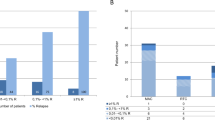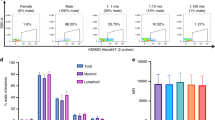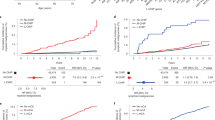Abstract
Within a prospective study we analyzed hematopoietic chimerism in serial peripheral blood samples taken from 55 patients with acute leukemias (ALL 21, AML 20, MDS 14) with a median age of 13.5 years at very short time intervals following allogeneic bone marrow transplantation (allo-BMT). The investigation was performed to determine the implications of mixed hematopoietic chimerism (MC) with regard to the clinical outcome in patients with acute leukemias after allo-BMT. Analysis of chimerism was performed by PCR of variable number of tandem repeat (VNTR) sequences with a maximum sensitivity of 0.8%. Thirteen male patients transplanted with the marrow of a female donor were also studied by amplification of a Y-chromosome- specific alphoid repeat (0.1–0.01% sensitivity). VNTR analysis in 55 patients revealed complete chimerism (CC) in 36 cases, MC in 18 follow-ups and autologous recovery in one patient. Quantitative analysis of MC identified 10/18 patients with increasing autologous patterns in whom 9/10 subsequently relapsed. The patient with autologous recovery relapsed as well. Eight of 18 patients with MC showed decreasing amounts of autologous DNA and became CC upon further follow-up. In contrast, only 7/36 patients with CC in the prior analysis of chimerism status relapsed. However, in 4/7 patients the interval between last CC confirmation and relapse was more than 4 months. In 2/7 patients autologous DNA was not detectable in peripheral blood but in bone marrow aspirates. One of these seven patients developed a fulminant relapse within 3 weeks. The probability of relapse-free survival for patients with CC is 0.67 (n = 36), for patients with decreasing MC 1.0 (n = 8) and for patients with increasing MC 0.1 (n = 10). In summary, the results demonstrate that serial and quantitative chimerism analysis at short time intervals by PCR provides a reliable and rapid screening method for the early detection of recurrence of underlying disease and is therefore a prognostic tool to identify patients at highest risk of relapse.
This is a preview of subscription content, access via your institution
Access options
Subscribe to this journal
Receive 12 print issues and online access
$259.00 per year
only $21.58 per issue
Buy this article
- Purchase on Springer Link
- Instant access to full article PDF
Prices may be subject to local taxes which are calculated during checkout
Similar content being viewed by others
Author information
Authors and Affiliations
Rights and permissions
About this article
Cite this article
Bader, P., Beck, J., Frey, A. et al. Serial and quantitative analysis of mixed hematopoietic chimerism by PCR in patients with acute leukemias allows the prediction of relapse after allogeneic BMT. Bone Marrow Transplant 21, 487–495 (1998). https://doi.org/10.1038/sj.bmt.1701119
Received:
Accepted:
Published:
Issue Date:
DOI: https://doi.org/10.1038/sj.bmt.1701119
Keywords
This article is cited by
-
Chimerism analysis for clinicians: a review of the literature and worldwide practices
Bone Marrow Transplantation (2022)
-
Lineage-specific early complete donor chimerism and risk of relapse after allogeneic hematopoietic stem cell transplantation for acute myeloid leukemia
Bone Marrow Transplantation (2022)
-
Monitoring minimal residual/relapsing disease after allogeneic haematopoietic stem cell transplantation in adult patients with acute lymphoblastic leukaemia
Bone Marrow Transplantation (2020)
-
Impact of early chimerism status on clinical outcome in children with acute lymphoblastic leukaemia after haematopoietic stem cell transplantation
BMC Cancer (2019)
-
G-CSF-primed haplo-identical HSCT with intensive immunosuppressive and myelosuppressive treatments does not increase the risk of pre-engraftment bloodstream infection: a multicenter case–control study
European Journal of Clinical Microbiology & Infectious Diseases (2019)



